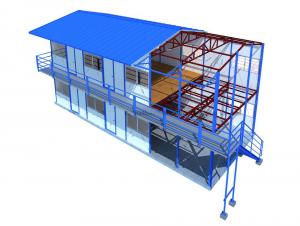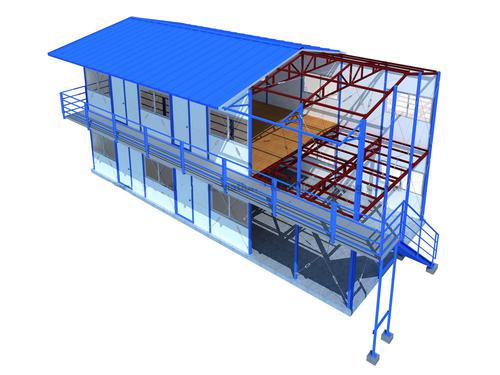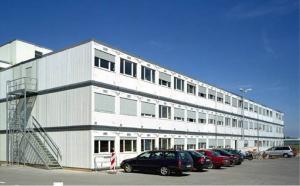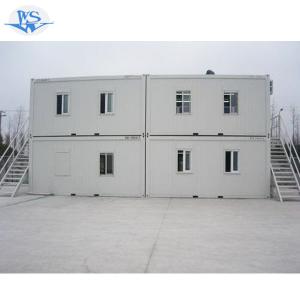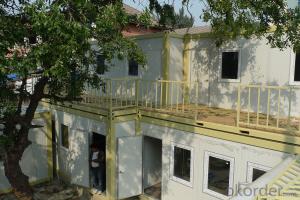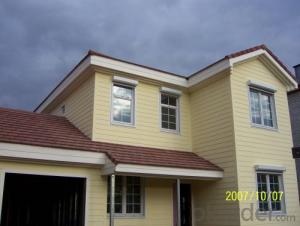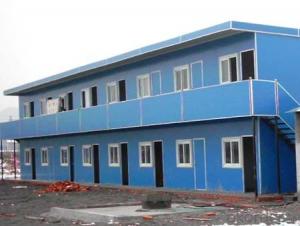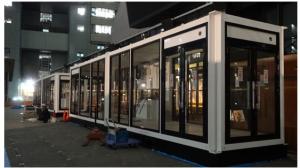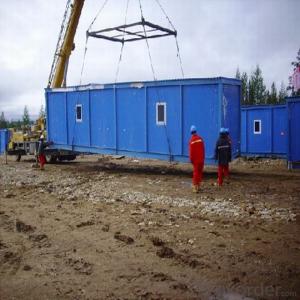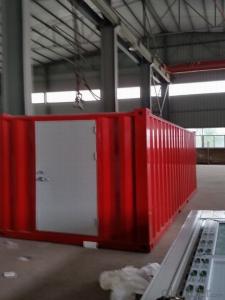Good Quality Container house for House from Factory
- Loading Port:
- Tianjin
- Payment Terms:
- TT or LC
- Min Order Qty:
- 1 set
- Supply Capability:
- 10000 set/month
OKorder Service Pledge
OKorder Financial Service
You Might Also Like
Good Quality Container house for House
1.Structure of Good Quality Container house for House
As an international recognized product, modular houses have the advantage of good insulation, excellent sealing, flexible combination and freely movement. It has been used in construction, commerce, industry, education, mining, petroleum, disaster and military affairs.
With the fixed size, the modular house could be designed based on the function and combined together in three-dimensional direction. Fast installation lies on the individual flat package and the prefabricated components. The modular houses can be assembled and reassembled for re transportation via road, train and sea.
2.Main Features of Good Quality Container house for House:
-Short Lead-time
Prefabricated: fabrication occurs in parallel with site preparation
Design for easy installation
Product could be installed whatever the weather condition
-Safety
Statics based on wind, snow load, seismic conditions
Floor: Q235 steel,height 140mm, thickness 3.75mm
Fireproof material (glass wool, steel even for the ceiling…)
Thickness and resistance of the panels (75mm + 0.5mm steel sheets / U profile / Rivets)
-Comfort
panels: thickness 75mm with glass wool (a very good insulation material) with the highest density available
connection between panels is without thermal bridge
gaskets have been added in several parts of the modules to achieve a very good air-tighness
noise reduction is insured by a gap between roof and floor and also by the glass wool in the panels that is a good sound isolation material
new window system for better airtighness
-Flexibility
3 storeys / no horizontal limit
total surface could be adjusted during the life of the project
Image - Recognition
A safe, nice looking, comfortable space that would be recognised by your customers, your management and also by the users,meanwhile could greatly enhance the corporate image.
Sustainability - Environement friendly - Social Responsibility
Long life span
Good isolation of the modules (panels of 75mm glass wool high density 64 kg/m3, few thermal bridge, gaskets for airtightness....) that anables a lower consumption of energy in winter (heater) and in summer (air conditionning)
No waste on site: prefabricated modules
Limited waste during manufacturing: LEAN management and standardization
Limited environmental impact on site: no voice, fast installation, fast removal of modules at the end of the project, light and most of the time removable foundations
3. Good Quality Container house for House Images
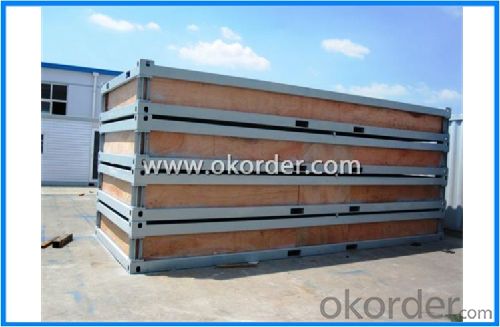

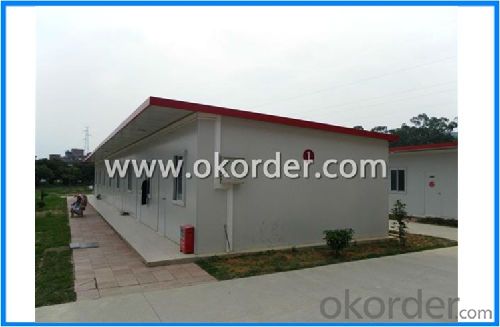
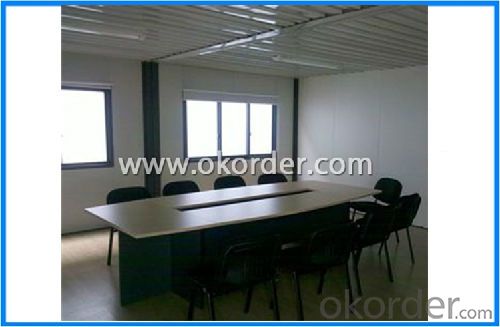
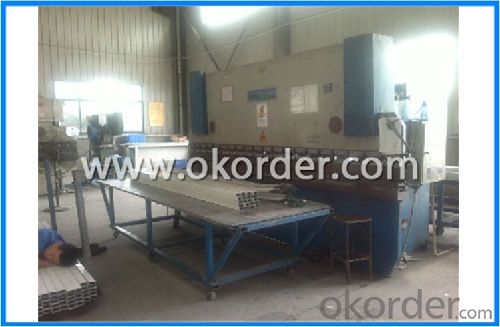
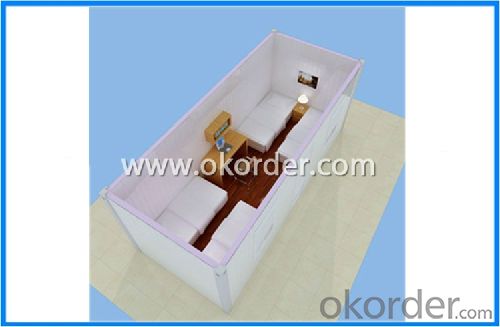
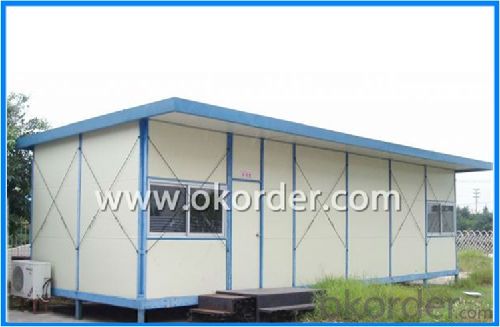
4. Good Quality Container house for House Specification
| Suspending floor | ||
| The light steel painted suspending floor is easy to assemble. The height can be customized from 300mm to 600mm. It needs the simple concrete blocks as foundation which can save the overall costs and time. It is widely used in high humidity to keep indoor ground dry. | ||
| Size and Load | ||
| Size | nM+160 M is module (n=4,5,6… 1M=1820mm) Single storey wall/ridge height: 2865mm/3560mm Two storey wall/ridge height: 5715mm / 6410mm Three storey wall /ridge height: 8565mm / 9260mm | |
| Roof live load | 0.3KN/㎡ | |
| Wind load | 0.45KN/㎡ | |
| Snow load | 0.5KN/㎡ | |
| Steel structure | From -15℃ to 50℃ | |
| Insulation | ||
| Rock wool | ||
| Glass wool | ||
| PU | ||
| Roof | ||
| Color steel sheet | Upper plate: 0.3mm galvanzied and coated color steel sheet Lower plate: 0.25mm galvanzied and coated color steel sheet | |
| Insulation | Standard:EPS with 50mm thick Option:EPS with 75mm thick Glass wool with 50mm thick Glass wool with 75mm thick | |
| Ceiling | Standard:gypsum board Option:Mineral wool acoustic panel, PVC panel | |
| Floor | ||
| Material | Without suspending floor system: Concrete foundation + ceramic tile floor With suspending floor system: 12mm OSB board + PVC floor or laminated floor | |
| Formaldehyde | ||
| moistureproof | ||
| Wall | ||
| Outer layer | 0.25mm galvanzied and coated color steel sheet | |
| Insulation | Standard: 50mm EPS Option: 75mm EPS 50mm glasswool 75mm glass wool | |
| Inner layer | 0.25mm galvanzied and coated color steel sheet | |
| Door | ||
| Size | Standard: 960*2030mm 750*2000mm Option: design according to requirement | |
| Material | Standard:SIP door Option: steel door security door | |
| Window | ||
| Size | 1735*932mm 1735*482mm | |
| Frame | Standard:PVC Option:aluminium | |
| Glass | 4mm thick | |
| Electric | ||
| Fittings | ||
| Socket | Multifunctional socket Option: American standard, European standard, British Standard, Australia standard, etc. | |
| Wiring | BV-1.5mm² BV-2.5mm² BV-4mm² | |
| Voltage | 220/380V | |
| Breaker | Miniature circuit breaker | |
| Structure painting | ||
| Protection against oxidation | Abrasive blasting | |
| Color | Blue | |
| Thicknes | 80µm | |
| Painting | Primer:epoxy Finish: crylic acid | |
5.FAQ
1.How about the installation? For example, the time and cost?
To install 200sqm house needs only 45 days by 6 professional workers. The salary of enginner is USD150/day, and for workers, it's 100/day.
2.How long is the life span of the house?
Around 50 years
3. And what about the loading quantity?
One 40'container can load 140sqm of house.

- Q: Can container houses be designed with a fireplace?
- Yes, container houses can be designed with a fireplace. The design may require proper insulation and ventilation to ensure safety and efficient operation of the fireplace within the container structure.
- Q: Can container houses be designed with a built-in security system?
- Yes, container houses can definitely be designed with a built-in security system. In fact, many container house manufacturers and designers are aware of the importance of security measures and offer various options to enhance the safety and security of these homes. One common approach is to incorporate surveillance cameras as part of the security system. These cameras can be strategically placed around the house to monitor the surroundings and deter potential intruders. Additionally, motion sensors can be installed to detect any movement around the property and trigger an alarm if necessary. Another important aspect of security is the entry points of the container house. Manufacturers can equip the doors and windows with robust locks and reinforced materials to make them more secure. Some designs even include smart locks that can be controlled remotely via a smartphone, allowing homeowners to lock and unlock their doors from anywhere. Furthermore, container houses can be integrated with security systems that include features like alarm systems, smoke detectors, and even home automation capabilities. These systems can be connected to a central control panel, which allows homeowners to easily monitor and control all aspects of their security system. It is important to note that while container houses can be designed with a built-in security system, the level of security ultimately depends on the specific features and technologies implemented. Homeowners should carefully consider their security needs and consult with professionals to ensure that the chosen security system meets their requirements.
- Q: Can container houses be built with a traditional office setup?
- Certainly, traditional office setups can indeed be created within container houses. By carefully planning and designing, container houses can be converted into office spaces that are both practical and comfortable. The modular nature of shipping containers allows for easy customization and configuration, enabling the creation of separate office areas within the container house. To achieve a traditional office setup, one can incorporate essential elements such as desks or workstations, chairs, storage cabinets, lighting fixtures, and electrical outlets. It is also important to ensure proper insulation, ventilation, and climate control in order to establish a pleasant working environment. Containers can be combined or stacked to form larger office spaces or divided into smaller individual offices or meeting rooms. Natural light can be introduced through the addition of windows and skylights, while doors can be installed to ensure privacy and security. With the appropriate layout and design, container houses have the potential to offer a professional and efficient workspace for a variety of office activities. Furthermore, container houses can be easily modified and expanded if necessary. If the traditional office setup needs to be enlarged or adapted in the future, additional containers can be added or removed to accommodate changing requirements. All in all, container houses have the ability to be transformed into versatile and practical office spaces, providing an alternative and sustainable solution to traditional office setups.
- Q: Are container houses resistant to floods?
- The resistance of container houses to floods can vary depending on their construction and location. Measures can be taken to enhance their structural integrity and flood resistance. Elevating the containers on stilts or pillars can prevent them from being submerged in floodwaters. Additionally, applying proper insulation, waterproofing, and sealants can prevent water from infiltrating the house during a flood. It is also essential to securely anchor the container house to its foundation to withstand the force of floodwaters. However, it is important to acknowledge that no building is entirely flood-proof, and the severity and duration of a flood can impact the resilience of any structure, including container houses. Therefore, consulting experts and complying with local building codes and regulations is recommended to maximize the flood resistance of container houses in flood-prone areas.
- Q: How do container houses compare to traditional houses in terms of durability?
- Container houses are generally considered to be more durable than traditional houses. This is because they are constructed using steel shipping containers that are designed to withstand harsh weather conditions and heavy loads. Additionally, container houses are often built with reinforced structures, making them more resistant to natural disasters such as earthquakes and hurricanes. However, it is important to note that the overall durability of a container house can vary depending on the quality of construction and maintenance practices.
- Q: What kind of villa generally?
- a row of two to four layers together, each several units share the external walls, a unified graphic design and independent portal. Townhouse Villa is currently one of the most affordable villas taking the form.
- Q: Can container houses be financed or insured?
- Container houses can indeed be financed and insured. Various banks and financial institutions offer loans that are specifically designed for alternative housing choices such as container houses. These loans typically come with terms and conditions that are similar to traditional mortgages. When it comes to insurance, container houses can be insured just like any other residential property. However, it's important to keep in mind that insurance companies might have specific requirements or considerations when it comes to insuring container houses. Factors like the quality of construction, location, and safety features can affect the availability and cost of insurance coverage. To ensure that you have adequate coverage for your container house, it's advisable to seek guidance from a professional insurance agent or broker who specializes in alternative housing options. They can assist you throughout the process and help you find the insurance coverage that suits your container house.
- Q: Are container houses suitable for yoga or wellness retreats?
- Yes, container houses can be suitable for yoga or wellness retreats. Container houses offer a unique and sustainable accommodation option that can enhance the overall experience of a yoga or wellness retreat. Firstly, container houses can be easily customized to create the perfect environment for yoga or wellness activities. The open floor plan of container houses allows for spacious and versatile yoga studios or meditation spaces to be created. The natural light that can enter through large windows or skylights in container houses can create a serene and peaceful atmosphere, essential for yoga and wellness practices. Additionally, container houses can be designed to incorporate eco-friendly features that align with the principles of yoga and wellness retreats. These houses can be equipped with solar panels, rainwater harvesting systems, and energy-efficient appliances, reducing the environmental impact and promoting sustainability. Container houses also offer the advantage of mobility. They can be easily transported to various locations, making them ideal for hosting retreats in different settings, such as near mountains, forests, or beachfronts. This mobility allows organizers to create unique and immersive experiences for participants, contributing to their overall well-being. Moreover, container houses are cost-effective compared to traditional brick and mortar structures, allowing retreat organizers to allocate more resources towards creating meaningful experiences for participants. This affordability can make yoga and wellness retreats more accessible to a wider audience, promoting inclusivity and diversity. In conclusion, container houses provide a suitable and sustainable option for yoga or wellness retreats. Their customizable nature, eco-friendly features, mobility, and cost-effectiveness make them an attractive choice for organizers looking to create a serene and immersive environment that aligns with the principles of yoga and wellness.
- Q: Are container houses suitable for small business owners?
- Yes, container houses can be suitable for small business owners for several reasons. Firstly, container houses are cost-effective compared to traditional brick and mortar structures. Small business owners often have limited budgets, and container houses provide an affordable option for setting up a business location. Secondly, container houses are highly versatile and customizable. They can be modified and tailored to meet the specific needs of different types of businesses. Whether it is a retail store, office space, or a small café, container houses can be adapted to create a functional and attractive workspace. Additionally, container houses are portable and can be easily relocated. This feature is particularly beneficial for small business owners who may need to change their location or expand their business in the future. Container houses can be easily transported to a new site, saving time and money on construction costs. Moreover, container houses are eco-friendly and sustainable. They are often made from recycled materials, reducing the environmental impact associated with traditional construction methods. Small business owners can align their business with sustainable practices by choosing a container house as their workspace. Overall, container houses provide a practical and affordable solution for small business owners. They offer versatility, cost-effectiveness, portability, and eco-friendliness, making them a suitable option for entrepreneurs with limited resources but big ambitions.
- Q: Are container houses insulated?
- Yes, container houses can be insulated. Insulation is an important aspect of container house construction as it helps regulate temperature, reduces energy consumption, and creates a comfortable living environment. There are several insulation options available for container houses, including spray foam insulation, rigid foam insulation, and fiberglass insulation. These insulation materials are typically applied to the walls, floors, and ceilings of the container to prevent heat transfer and maintain a consistent indoor temperature. Additionally, insulation also helps in soundproofing the container house, making it more quiet and peaceful.
Send your message to us
Good Quality Container house for House from Factory
- Loading Port:
- Tianjin
- Payment Terms:
- TT or LC
- Min Order Qty:
- 1 set
- Supply Capability:
- 10000 set/month
OKorder Service Pledge
OKorder Financial Service
Similar products
Hot products
Hot Searches
